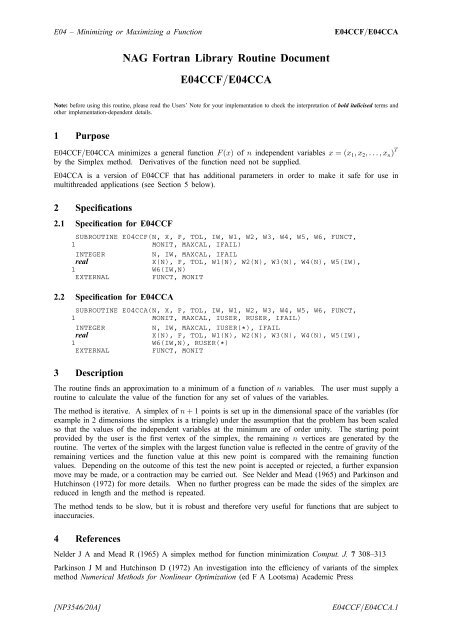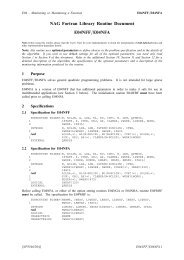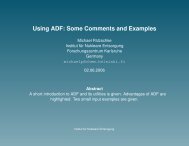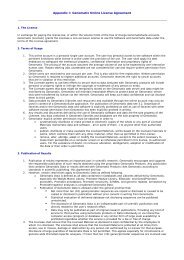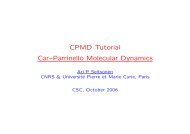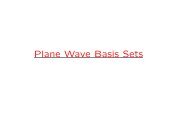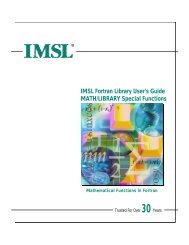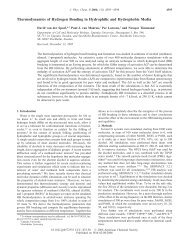NAG Fortran Library Routine Document E04CCF=E04CCA
NAG Fortran Library Routine Document E04CCF=E04CCA
NAG Fortran Library Routine Document E04CCF=E04CCA
You also want an ePaper? Increase the reach of your titles
YUMPU automatically turns print PDFs into web optimized ePapers that Google loves.
E04 – Minimizing or Maximizing a Function<br />
<strong>E04CCF=E04CCA</strong><br />
<strong>NAG</strong> <strong>Fortran</strong> <strong>Library</strong> <strong>Routine</strong> <strong>Document</strong><br />
<strong>E04CCF=E04CCA</strong><br />
Note: before using this routine, please read the Users’ Note for your implementation to check the interpretation of bold italicised terms and<br />
other implementation-dependent details.<br />
1 Purpose<br />
<strong>E04CCF=E04CCA</strong> minimizes a general function F ðxÞ of n independent variables x ¼ðx 1 ;x 2 ; ...;x n Þ T<br />
by the Simplex method. Derivatives of the function need not be supplied.<br />
E04CCA is a version of E04CCF that has additional parameters in order to make it safe for use in<br />
multithreaded applications (see Section 5 below).<br />
2 Specifications<br />
2.1 Specification for E04CCF<br />
SUBROUTINE E04CCF(N, X, F, TOL, IW, W1, W2, W3, W4, W5, W6, FUNCT,<br />
1 MONIT, MAXCAL, IFAIL)<br />
INTEGER N, IW, MAXCAL, IFAIL<br />
real X(N), F, TOL, W1(N), W2(N), W3(N), W4(N), W5(IW),<br />
1 W6(IW,N)<br />
EXTERNAL FUNCT, MONIT<br />
2.2 Specification for E04CCA<br />
SUBROUTINE E04CCA(N, X, F, TOL, IW, W1, W2, W3, W4, W5, W6, FUNCT,<br />
1 MONIT, MAXCAL, IUSER, RUSER, IFAIL)<br />
INTEGER N, IW, MAXCAL, IUSER(*), IFAIL<br />
real X(N), F, TOL, W1(N), W2(N), W3(N), W4(N), W5(IW),<br />
1 W6(IW,N), RUSER(*)<br />
EXTERNAL FUNCT, MONIT<br />
3 Description<br />
The routine finds an approximation to a minimum of a function of n variables. The user must supply a<br />
routine to calculate the value of the function for any set of values of the variables.<br />
The method is iterative. A simplex of n þ 1 points is set up in the dimensional space of the variables (for<br />
example in 2 dimensions the simplex is a triangle) under the assumption that the problem has been scaled<br />
so that the values of the independent variables at the minimum are of order unity. The starting point<br />
provided by the user is the first vertex of the simplex, the remaining n vertices are generated by the<br />
routine. The vertex of the simplex with the largest function value is reflected in the centre of gravity of the<br />
remaining vertices and the function value at this new point is compared with the remaining function<br />
values. Depending on the outcome of this test the new point is accepted or rejected, a further expansion<br />
move may be made, or a contraction may be carried out. See Nelder and Mead (1965) and Parkinson and<br />
Hutchinson (1972) for more details. When no further progress can be made the sides of the simplex are<br />
reduced in length and the method is repeated.<br />
The method tends to be slow, but it is robust and therefore very useful for functions that are subject to<br />
inaccuracies.<br />
4 References<br />
Nelder J A and Mead R (1965) A simplex method for function minimization Comput. J. 7 308–313<br />
Parkinson J M and Hutchinson D (1972) An investigation into the efficiency of variants of the simplex<br />
method Numerical Methods for Nonlinear Optimization (ed F A Lootsma) Academic Press<br />
[NP3546/20A]<br />
<strong>E04CCF=E04CCA</strong>.1
<strong>E04CCF=E04CCA</strong><br />
<strong>NAG</strong> <strong>Fortran</strong> <strong>Library</strong> Manual<br />
5 Parameters<br />
1: N – INTEGER Input<br />
On entry: the number n of independent variables.<br />
Constraint: N> 0.<br />
2: X(N) – real array Input/Output<br />
On entry: a guess at the position of the minimum. Note that the problem should be scaled so that<br />
the values of the XðiÞ are of order unity.<br />
On exit: the value of x corresponding to the function value in F.<br />
3: F–real Output<br />
On exit: the lowest function value found.<br />
4: TOL – real Input<br />
On entry: the error tolerable in the result, as follows:<br />
If f i , for i ¼ 1; 2; ...;nþ 1, are the individual function values at the vertices of a simplex and f m is<br />
the mean of these values, then the routine will terminate when<br />
vffiffiffiffiffiffiffiffiffiffiffiffiffiffiffiffiffiffiffiffiffiffiffiffiffiffiffiffiffiffiffiffiffiffiffiffiffiffiffi<br />
u 1 X<br />
t<br />
nþ1<br />
ðf<br />
n þ 1 i f m Þ 2 < TOL:<br />
i¼1<br />
Constraint: TOL must be greater than or equal to the machine precision (see Chapter X02).<br />
5: IW – INTEGER Input<br />
On entry: the value N þ 1.<br />
Constraint: IW¼ N þ 1.<br />
6: W1(N) – real array Workspace<br />
7: W2(N) – real array Workspace<br />
8: W3(N) – real array Workspace<br />
9: W4(N) – real array Workspace<br />
10: W5(IW) – real array Workspace<br />
11: W6(IW,N) – real array Workspace<br />
12: FUNCT – SUBROUTINE, supplied by the user. External Procedure<br />
FUNCT must calculate the value of the function at XC and assign this value to FC. It should be<br />
tested separately before being used in conjunction with <strong>E04CCF=E04CCA</strong>.<br />
The specification of FUNCT for E04CCF is:<br />
SUBROUTINE FUNCT(N, XC, FC)<br />
INTEGER<br />
N<br />
real XC(N), FC<br />
The specification of FUNCT for E04CCA is:<br />
SUBROUTINE FUNCT(N, XC, FC, IUSER, RUSER)<br />
INTEGER N, IUSER(*)<br />
real XC(N), FC, RUSER(*)<br />
1: N – INTEGER Input<br />
On entry: the number n of variables.<br />
<strong>E04CCF=E04CCA</strong>.2<br />
[NP3546/20A]
E04 – Minimizing or Maximizing a Function<br />
<strong>E04CCF=E04CCA</strong><br />
2: XC(N) – real array Input<br />
On entry: the point x at which the function is required.<br />
3: FC – real Output<br />
On exit: the value of the function FðxÞ at the current point x.<br />
Note: the following are additional parameters for specific use of FUNCT with E04CCA.<br />
E04CCF therefore need not read the remainder of this description.<br />
Users of<br />
4: IUSER(*) – INTEGER array User Workspace<br />
5: RUSER(*) –real array User Workspace<br />
FUNCT is called from E04CCA with the parameters IUSER and RUSER as supplied to<br />
E04CCA. You are free to use the arrays IUSER and RUSER to supply information to<br />
FUNCT.<br />
FUNCT must be declared as EXTERNAL in the (sub)program from which <strong>E04CCF=E04CCA</strong> is<br />
called. Parameters denoted as Input must not be changed by this procedure.<br />
13: MONIT – SUBROUTINE, supplied by the user. External Procedure<br />
MONIT is called once every iteration in <strong>E04CCF=E04CCA</strong>. It can be used to print out the current<br />
values of any selection of its parameters but must not be used to change the values of the<br />
parameters.<br />
The specification of MONIT for E04CCF is:<br />
SUBROUTINE MONIT(FMIN, FMAX, SIM, N, IS, NCALL)<br />
INTEGER N, IS, NCALL<br />
real FMIN, FMAX, SIM(IS,N)<br />
The specification of MONIT for E04CCA is:<br />
SUBROUTINE MONIT(FMIN, FMAX, SIM, N, IS, NCALL, IUSER, RUSER)<br />
INTEGER N, IS, NCALL, IUSER(*)<br />
real FMIN, FMAX, SIM(IS,N), RUSER(*)<br />
1: FMIN – real Input<br />
On entry: the smallest function value in the current simplex.<br />
2: FMAX – real Input<br />
On entry: the largest function value in the current simplex.<br />
3: SIM(IS,N) – real array Input<br />
On entry: the rows of SIM contain the position vectors of the vertices of the current<br />
simplex.<br />
4: N – INTEGER Input<br />
On entry: the number of variables.<br />
5: IS – INTEGER Input<br />
On entry: the first dimension of the array SIM.<br />
6: NCALL – INTEGER Input<br />
On entry: the number of times that FUNCT has been called so far.<br />
[NP3546/20A]<br />
<strong>E04CCF=E04CCA</strong>.3
<strong>E04CCF=E04CCA</strong><br />
<strong>NAG</strong> <strong>Fortran</strong> <strong>Library</strong> Manual<br />
Note: the following are additional parameters for specific use of MONIT with E04CCA. Users of<br />
E04CCF therefore need not read the remainder of this description.<br />
7: IUSER(*) – INTEGER array User Workspace<br />
8: RUSER(*) –real array User Workspace<br />
MONIT is called from E04CCA with the parameters IUSER and RUSER as supplied to<br />
E04CCA. You are free to use the arrays IUSER and RUSER to supply information to<br />
MONIT.<br />
MONIT must be declared as EXTERNAL in the (sub)program from which <strong>E04CCF=E04CCA</strong> is<br />
called. Parameters denoted as Input must not be changed by this procedure.<br />
14: MAXCAL – INTEGER Input<br />
On entry: the maximum number of function evaluations to be allowed.<br />
Constraint: MAXCAL 1.<br />
15: IFAIL – INTEGER Input/Output<br />
Note: for E04CCA, IFAIL does not occur in this position in the parameter list.<br />
parameters described below.<br />
See the additional<br />
On entry: IFAIL must be set to 0, 1 or 1. Users who are unfamiliar with this parameter should<br />
refer to Chapter P01 for details.<br />
On exit: IFAIL ¼ 0 unless the routine detects an error (see Section 6).<br />
For environments where it might be inappropriate to halt program execution when an error is<br />
detected, the value 1 or 1 is recommended. If the output of error messages is undesirable, then the<br />
value 1 is recommended. Otherwise, for users not familiar with this parameter the recommended<br />
value is 0. When the value 1 or 1 is used it is essential to test the value of IFAIL on exit.<br />
Note: the following are additional parameters for specific use with E04CCA. Users of E04CCF therefore need<br />
not read the remainder of this section.<br />
15: IUSER(*) – INTEGER array User Workspace<br />
Note: the dimension of the array IUSER must be at least 1.<br />
IUSER is not used by E04CCA, but is passed directly to the external procedures FUNCT and<br />
MONIT and may be used to pass information to those routines.<br />
16: RUSER(*) –real array User Workspace<br />
Note: the dimension of the array RUSER must be at least 1.<br />
RUSER is not used by E04CCA, but is passed directly to the external procedures FUNCT and<br />
MONIT and may be used to pass information to those routines.<br />
17: IFAIL – INTEGER Input/Output<br />
Note: see the parameter description for IFAIL above.<br />
6 Error Indicators and Warnings<br />
If on entry IFAIL ¼ 0or 1, explanatory error messages are output on the current error message unit (as<br />
defined by X04AAF).<br />
Errors or warnings detected by the routine:<br />
IFAIL ¼ 1<br />
On entry, N < 1,<br />
or TOL < machine precision (see Chapter X02),<br />
or IW 6¼ N þ 1,<br />
<strong>E04CCF=E04CCA</strong>.4<br />
[NP3546/20A]
E04 – Minimizing or Maximizing a Function<br />
<strong>E04CCF=E04CCA</strong><br />
or MAXCAL < 1.<br />
IFAIL ¼ 2<br />
MAXCAL function evaluations have been completed, <strong>E04CCF=E04CCA</strong> has been terminated<br />
prematurely. Check the coding of the routine FUNCT before increasing the value of MAXCAL.<br />
7 Accuracy<br />
On a successful exit the accuracy will be as defined by TOL.<br />
8 Further Comments<br />
The time taken by the routine depends on the number of variables, the behaviour of the function and the<br />
distance of the starting point from the minimum. Each iteration consists of 1 or 2 function evaluations<br />
unless the size of the simplex is reduced, in which case n þ 1 function evaluations are required.<br />
9 Example<br />
To find a minimum of the function<br />
9.1 Program Text<br />
F ¼ e x 1<br />
ð4x 2 1 þ 2x 2 2 þ 4x 1 x 2 þ 2x 2 þ 1Þ:<br />
Note: the listing of the example program presented below uses bold italicised terms to denote precision-dependent details. Please read the<br />
Users’ Note for your implementation to check the interpretation of these terms. As explained in the Essential Introduction to this manual,<br />
the results produced may not be identical for all implementations.<br />
Note: the following program illustrates the use of E04CCF. An equivalent program illustrating the use of<br />
E04CCA is available with the supplied <strong>Library</strong> and is also available from the <strong>NAG</strong> web site.<br />
* E04CCF Example Program Text<br />
* Mark 14 Revised. <strong>NAG</strong> Copyright 1989.<br />
* .. Parameters ..<br />
INTEGER N, IW<br />
PARAMETER<br />
(N=2,IW=N+1)<br />
INTEGER<br />
NOUT<br />
PARAMETER<br />
(NOUT=6)<br />
* .. Scalars in Common ..<br />
INTEGER<br />
IMONIT<br />
* .. Local Scalars ..<br />
real F, TOL<br />
INTEGER I, IFAIL, MAXCAL<br />
* .. Local Arrays ..<br />
real SIM(IW,N), W1(N), W2(N), W3(N), W4(N), W5(IW),<br />
+ X(N)<br />
* .. External Functions ..<br />
real<br />
X02AJF<br />
EXTERNAL<br />
X02AJF<br />
* .. External Subroutines ..<br />
EXTERNAL E04CCF, FUNCT, MONIT<br />
* .. Intrinsic Functions ..<br />
INTRINSIC<br />
SQRT<br />
* .. Common blocks ..<br />
COMMON<br />
/OUTP/IMONIT<br />
* .. Executable Statements ..<br />
WRITE (NOUT,*) ’E04CCF Example Program Results’<br />
* ** Set IMONIT to 1 to obtain monitoring information **<br />
IMONIT = 0<br />
X(1) = -1.0e0<br />
X(2) = 1.0e0<br />
TOL = SQRT(X02AJF())<br />
MAXCAL = 100<br />
IFAIL = 0<br />
*<br />
[NP3546/20A]<br />
<strong>E04CCF=E04CCA</strong>.5
<strong>E04CCF=E04CCA</strong><br />
<strong>NAG</strong> <strong>Fortran</strong> <strong>Library</strong> Manual<br />
CALL E04CCF(N,X,F,TOL,IW,W1,W2,W3,W4,W5,SIM,FUNCT,MONIT,MAXCAL,<br />
+ IFAIL)<br />
*<br />
WRITE (NOUT,*)<br />
WRITE (NOUT,99999) ’Final function value is ’, F<br />
WRITE (NOUT,99999) ’at the point’, (X(I),I=1,N)<br />
WRITE (NOUT,99998) ’This has error number’, IFAIL<br />
STOP<br />
*<br />
99999 FORMAT (1X,A,2F12.4)<br />
99998 FORMAT (1X,A,I3)<br />
END<br />
*<br />
SUBROUTINE FUNCT(N,XC,FC)<br />
* .. Scalar Arguments ..<br />
real<br />
FC<br />
INTEGER<br />
N<br />
* .. Array Arguments ..<br />
real<br />
XC(N)<br />
* .. Intrinsic Functions ..<br />
INTRINSIC<br />
EXP<br />
* .. Executable Statements ..<br />
FC = EXP(XC(1))*(4.0e0*XC(1)*(XC(1)+XC(2))+2.0e0*XC(2)*(XC(2)<br />
+ +1.0e0)+1.0e0)<br />
RETURN<br />
END<br />
*<br />
SUBROUTINE MONIT(FMIN,FMAX,SIM,N,N1,NCALL)<br />
* .. Parameters ..<br />
INTEGER<br />
NOUT<br />
PARAMETER<br />
(NOUT=6)<br />
* .. Scalar Arguments ..<br />
real FMAX, FMIN<br />
INTEGER N, N1, NCALL<br />
* .. Array Arguments ..<br />
real<br />
SIM(N1,N)<br />
* .. Scalars in Common ..<br />
INTEGER<br />
IMONIT<br />
* .. Local Scalars ..<br />
INTEGER I, J<br />
* .. Common blocks ..<br />
COMMON<br />
/OUTP/IMONIT<br />
* .. Executable Statements ..<br />
IF (IMONIT.NE.0) THEN<br />
WRITE (NOUT,99999) ’After’, NCALL,<br />
+ ’ function calls, the value is’, FMIN, ’ with simplex’<br />
WRITE (NOUT,99998) ((SIM(I,J),J=1,N),I=1,N1)<br />
END IF<br />
RETURN<br />
*<br />
99999 FORMAT (1X,A,I5,A,F10.4,A)<br />
99998 FORMAT (1X,2F12.4)<br />
END<br />
9.2 Program Data<br />
None.<br />
9.3 Program Results<br />
E04CCF Example Program Results<br />
Final function value is 0.0000<br />
at the point 0.5000 -0.9999<br />
This has error number 0<br />
<strong>E04CCF=E04CCA</strong>.6 (last)<br />
[NP3546/20A]


